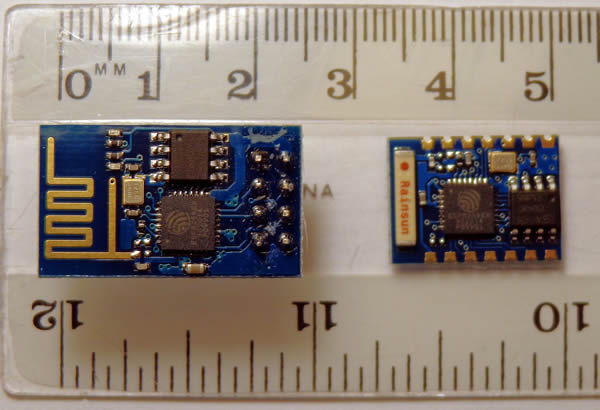
The DWiC Working Group is not committed to any particular WiFi controller, and indeed future manufacturers don't need to either as long as that controller meets the WiFi spec. However currently the ESP8266 modules have a wealth of information and many developers on the 'net.
They are priced at around $4.00 with free postage.

The ESP01 is on the left, ESP03 on the right. The eight pads on the right side of the ESP01 are a standard 0.1" connector and the antenna is obviously on the left. The ESP03 is smaller and with 7 pads along each side has easier access to pinouts. The ESP03's ceramic antenna is the component marked "rainsum" along the left edge.
Many references on the internet underutilize these modules as WiFi modems byconnecting the serial output to another micro-controller. Look for references as given below where groups are actually programming the ESP modules own microcontroller using script languages such as LUA. Loading firmware from the development PC is a simple matter using a $3.00 USB-serial dongle as referenced below.
Extra hardware is required to provide power and buffer motor current and inputs/outputs. Given that this extra hardware is similar to that in a DCC decoder it would fit on a piggybacked same size board.
The quickest way to get into these modules is to connect them to your PC via a USB to serial interface and power with two AA batteries (beware the modules are 3.5V).
This is all explained on Peter Jennings site at http://benlo.com/esp8266/ with a quick start guide, the Lua Loader and more.
Where to purchase experimental hardware:
Lua is a scripting language used on micro-controllers. The Lua Loader is here.
The Node Mcu Development Kit based on ESP8266, integates GPIO, PWM, IIC, 1-Wire and ADC all in one board. Code examples at : http://www.nodemcu.com/index_en.html#fr_54745c8bd775ef4b99000011.
To quickly load binaries onto an ESP module you use Flasher(Win32) or Flasher(Win64)